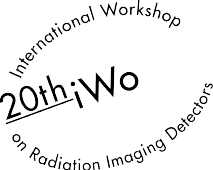Speaker
Description
Monocrystalline silicon is a well-established and widely used material in the field of X-ray detection and imaging, however, its low sensitivity to the photons with energy above 20 keV motivates the development of sensors made of high Z materials, like CdTe or GaAs. Semi-insulating (SI) GaAs is one of the promising candidates due to its advantageous properties. In comparison to silicon, it has about 20 times higher sensitivity for 12-60 keV X-rays and 3-5 times faster charge collection. In contrast to CdTe, it has no or minimal polarization effect and internal fluorescence photons have energies below range important for medical soft tissue imaging such as mammography. In this paper, we continue our study of 350 µm thick SI-GaAs sensor bump-bonded to the Timepix readout chip [1, 2]. Standard 300 µm thick silicon-based sensor was chosen as a reference for our test measurements. Firstly, homogeneity in terms of open beam image and flat-field corrected image was investigated. Secondly, spectrometric properties in counting (thresholded) mode as well as in energy (Time over Threshold) mode were studied. As a source of radiation, we used gamma rays from Am-241 (59.54 keV) and In α and β fluorescence photons (24.14 and 27.27 keV) in both counting and energy mode plus Cu, Mo, Cd fluorescence photons (8.04, 17.44 and 23.10 keV, respectively) in ToT mode. Thirdly, imaging properties were examined using X-ray source with micro-focal spot size of approx. 2 µm. Slanted edge method was used to determine the modulation transfer function (MTF) and the spatial resolution of the sensors. Also, images of several objects were taken for different energy thresholds, namely default sensor threshold (~3 keV for Si and ~6,5 keV for GaAs), 15 keV and 25 keV. In last measurement we tested contrast resolution limits of Timepix cameras with our fabricated testing object using nano-machining technique.
[1] Llopart, X., et al.: Timepix, a 65k programmable pixel readout chip for arrival time, energy and/or photon counting measurements, NIM in Phys. Res. A 581 (2007) 485-494.
[2] Zaťko, B., et al.: Imaging performance of Timepix detector based on semi-insulating GaAs. In Journal of Instrumentation, 2018, vol. 13, C01034.




